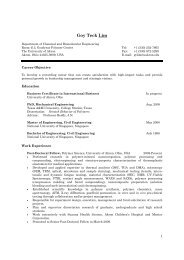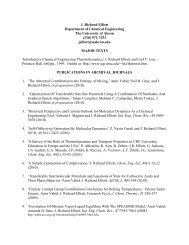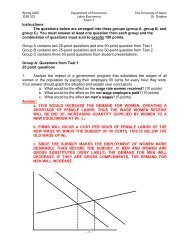Sociology of the Anarchists - Gozips.uakron.edu - The University of ...
Sociology of the Anarchists - Gozips.uakron.edu - The University of ...
Sociology of the Anarchists - Gozips.uakron.edu - The University of ...
Create successful ePaper yourself
Turn your PDF publications into a flip-book with our unique Google optimized e-Paper software.
Moving outside <strong>of</strong> <strong>the</strong> relatively easy-to-understand distinction between vandalism and<br />
violence, <strong>the</strong>re is a deeper analysis present in anarchist thought: authority wields—and in<br />
fact is based upon—violence. And why <strong>the</strong> violent response from police to mere property<br />
damage? Graeber (2002) observes “governments simply do not know how to deal with an<br />
overtly revolutionary movement that refuses to fall into familiar patterns <strong>of</strong> armed<br />
resistance” (p. 66).<br />
McLeod's work (1992, 1995) on media-generated perception <strong>of</strong> protest (particularly in his<br />
study <strong>of</strong> anarchist protests in Minneapolis during <strong>the</strong> mid-1980s), are useful in<br />
understanding <strong>the</strong> impact that <strong>the</strong> mass media has in <strong>the</strong> perception <strong>of</strong> violence in protest.<br />
He found (1995) that TV news stories <strong>of</strong> clashes between protesters and police (already a<br />
faulty dichotomy, he claims 85 ) caused less criticism <strong>of</strong> police and more criticism <strong>of</strong><br />
protesters when one-sided, but <strong>the</strong> opposite result with less one-sided stories. <strong>The</strong> less<br />
one-sided story also provoked greater identification with protesters than <strong>the</strong> o<strong>the</strong>r. <strong>The</strong><br />
study also showed that women viewing <strong>the</strong> news program tended to have more criticism<br />
<strong>of</strong> <strong>the</strong> police, less criticism <strong>of</strong> protesters, and more identification with protesters than<br />
men. Conservatives viewing <strong>the</strong> same TV stories were less likely to see <strong>the</strong> utility in<br />
protest and identified less with protesters than non-conservatives (in <strong>the</strong> study called<br />
“liberals”). McLeod states: “To <strong>the</strong> extent that one-sided portrayals predispose audience<br />
members to reject protesters and <strong>the</strong>ir ideas, <strong>the</strong> media narrow <strong>the</strong> boundaries <strong>of</strong> <strong>the</strong><br />
marketplace <strong>of</strong> ideas” (p. 18).<br />
Cobb-Reiley (1988) discusses <strong>the</strong> suppression <strong>of</strong> anarchist speakers, writers, and<br />
publishers in <strong>the</strong> early 20th century. In hearing legal cases against anarchists concerning<br />
“freedom <strong>of</strong> speech”, judges<br />
made it clear that belief in anarchism, was by definition, an<br />
abuse <strong>of</strong> freedom and, in all <strong>the</strong> cases, that belief was<br />
evidence enough to conclude anarchists intended to do<br />
harm and could, <strong>the</strong>refore, be punished (p. 57).<br />
Unsurprisingly, <strong>the</strong> US government classifies anarchist and anarchistic organizations as<br />
“terrorist” groups—now a quasi-<strong>of</strong>ficial designation for any group <strong>of</strong> people that opposes<br />
US hegemony. A 1999 FBI report (prior to “9/11” fervor) on terrorism stated that <strong>the</strong><br />
largest domestic threats were “animal rights and environmental extremists”, specifically<br />
<strong>the</strong> ALF and ELF (FBI 1999, p. 1). Ironically, <strong>the</strong> report clearly suggests that none <strong>of</strong><br />
<strong>the</strong>se “terrorist” attacks resulted in <strong>the</strong> death <strong>of</strong> any human beings (you can guarantee <strong>the</strong><br />
FBI would mention deaths from anarchists, were <strong>the</strong>re any!). However, a number <strong>of</strong><br />
deaths resulted from <strong>the</strong> acts <strong>of</strong> “rogue right-wing extremists”—which <strong>of</strong> course prompts<br />
<strong>the</strong> question: who are <strong>the</strong> non-rogue/establishment right-wing extremists (maybe <strong>the</strong><br />
government itself)? 86 In Congressional testimony, James Jarboe, Domestic Terrorism<br />
85 When stories are framed in terms <strong>of</strong> “protesters vs. police”, <strong>the</strong> political message (and motivations) <strong>of</strong><br />
protesters is lost or glossed-over. McLeod states that this “transference <strong>of</strong> protesters' intended opposition<br />
is significant because a group that challenges government policy is political, while a group that<br />
challenges police is criminal” (McLeod 1995, p. 6).<br />
86 See Gibbs (1989) for an attempt at sociologically defining “terrorism”, a definition that fails horribly—it<br />
never even mentions “state terrorism”!<br />
[ Williams 92 ] [ this is a draft. do not cite. ]






